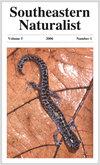A Review of Common Factors among Successful and Failed Efforts to Eradicate Invasive Vertebrates in Florida
IF 0.4
4区 环境科学与生态学
Q4 BIODIVERSITY CONSERVATION
引用次数: 0
Abstract
Abstract - Species invasions can alter ecosystems, decimate populations of native species, facilitate the spread of infectious diseases, and threaten industries like fisheries and agriculture. Significant resources and financial investments are often directed towards invasive species management (ISM) to prevent future introductions, to remove smaller populations, and to contain expanding populations. While prevention is the most important goal of ISM, focus may shift to removal (eradication) when prevention fails. Eradication attempts are costly and have not been inclusive of all invasive populations. These efforts are inherently difficult because they require an abundance of resources, must be executed before the population expands, can be disrupted by public opposition, and often require years of monitoring to confirm success. Regardless, even failed eradication attempts provide important lessons to potentially improve future eradication efforts. This review of 20 case studies in Florida assesses successful and failed eradication attempts to identify common factors that contributed to each outcome. More than half of the detailed failed eradication attempts either lacked communication from or were outright disrupted by stakeholders. Most successful eradications targeted fish or small mammals and removed <200 individuals. Nearly half of the successful eradications occurred on islands or within isolated bodies of water. Despite the abundance of invasive herpetofauna in Florida, there has yet to be a documented successful eradication effort targeting these species. While many barriers exist to publishing eradication outcomes, future eradication efforts should prioritize documentation to provide guidance to similar efforts. Future research should address the role of media coverage and outreach efforts regarding eradication success, especially efforts targeting charismatic species.佛罗里达根除入侵脊椎动物成功与失败的共同因素综述
摘要:物种入侵可以改变生态系统,大量减少本地物种的数量,促进传染病的传播,并威胁到渔业和农业等行业。大量的资源和财政投资通常用于入侵物种管理(ISM),以防止未来的引入,消除较小的种群,并控制不断扩大的种群。虽然预防是ISM最重要的目标,但当预防失败时,重点可能会转移到清除(根除)上。根除的努力是昂贵的,并没有包括所有的入侵种群。这些努力本身就很困难,因为它们需要丰富的资源,必须在人口增长之前执行,可能会受到公众反对的干扰,而且往往需要多年的监测才能确认成功。无论如何,即使是失败的根除尝试也为潜在地改进未来的根除工作提供了重要的经验教训。本文回顾了佛罗里达州的20个案例研究,评估了成功和失败的根除尝试,以确定导致每种结果的共同因素。在详细的失败的根除尝试中,一半以上要么缺乏与利益相关者的沟通,要么完全被利益相关者破坏。大多数成功的根除以鱼类或小型哺乳动物为目标,并清除了少于200个个体。近一半的成功根除发生在岛屿或孤立的水体内。尽管佛罗里达州有大量的侵入性爬行动物,但迄今为止还没有记录在案的成功根除这些物种的努力。虽然发表根除成果存在许多障碍,但未来的根除工作应优先考虑文件,为类似工作提供指导。未来的研究应解决媒体报道和推广工作在根除成功方面的作用,特别是针对魅力物种的努力。
本文章由计算机程序翻译,如有差异,请以英文原文为准。
求助全文
约1分钟内获得全文
求助全文
来源期刊

Southeastern Naturalist
环境科学-生态学
CiteScore
1.20
自引率
16.70%
发文量
31
审稿时长
18-36 weeks
期刊介绍:
The Southeastern Naturalist covers all aspects of the natural history sciences of terrestrial, freshwater, and marine organisms and the environments of the southeastern portion of North America, roughly bounded from North Carolina south to Florida, west to Texas, north to Oklahoma, and east back to North Carolina. Manuscripts based on field studies outside of this region that provide information on species within this region may be considered at the Editor’s discretion.
 求助内容:
求助内容: 应助结果提醒方式:
应助结果提醒方式:


